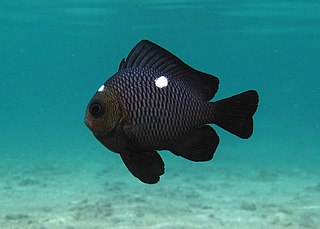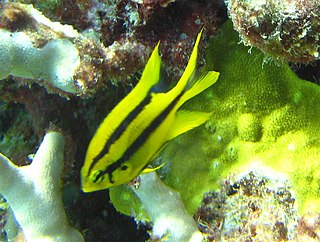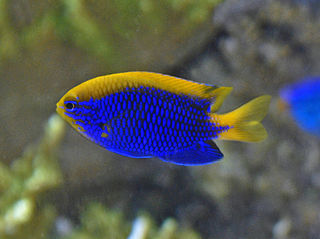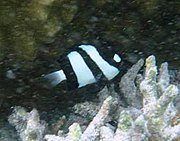
Dascyllus is a genus of fish in the family Pomacentridae. They are usually commensals with corals.

Fire corals (Millepora) are a genus of colonial marine organisms that exhibit physical characteristics similar to that of coral. The name coral is somewhat misleading, as fire corals are not true corals but are instead more closely related to Hydra and other hydrozoans, making them hydrocorals. They make up the only genus in the monotypic family Milleporidae.
White tail or whitetail may refer to:

The Indo-Pacific sergeant (Abudefduf vaigiensis) may also be known as the Sergeant major although this name is usually reserved for the closely related species Abudefduf saxatilis.

The threespot dascyllus, also known as the domino damsel or simply domino, is a species of damselfish from the family Pomacentridae. It is native to the Indo-Pacific from the Red Sea and East Africa, to the Pitcairn Islands, southern Japan, and Australia. Its grey to black body has two lateral white spots and one between the eyes like domino hence the name; the threespot dascyllus grows up to 13 cm in length. Coloration is somewhat variable; the spot on the forehead may be absent and the lateral spots very much reduced. It feeds on algae, copepods and other planktonic crustaceans.

Chrysiptera cyanea is a species of damselfish native to the Indian and western Pacific Oceans. Common names include blue damselfish, blue demoiselle, blue devil, cornflower sergeant-major, Hedley's damselfish, red tail Australian damsel, sapphire devil, and sky-blue damsel.

Dascyllus melanurus, known commonly as the four stripe damselfish, blacktail dascyllus, humbug damselfish, blacktail damselfish, and blacktail humbug, is a species of fish in the family Pomacentridae. It is native to the western Pacific Ocean. It is sometimes kept as an aquarium pet.

Dascyllus reticulatus, known commonly as the reticulate dascyllus or two-stripe damselfish among other vernacular names, is a species of marine fish in the family Pomacentridae.

Chrysiptera taupou, known commonly as the southseas devil, southseas demoiselle, and Fiji damsel, is a species of damselfish. It is native to the western Pacific Ocean from the Coral Sea to Samoa.

Chrysiptera talboti, known commonly as Talbot's damselfish and Talbot's demoiselle, is a species of damselfish. It is a marine fish from the eastern Indian Ocean and western Pacific. The specific name honours the fisheries scientist Frank H. Talbot the director of the Australian Museum in Sydney, the collector of the type.

Chrysiptera hemicyanea, known commonly as the azure damselfish, azure demoiselle, half-blue demoiselle, and yellow-dipped damsel, is a species of damselfish.

Neoglyphidodon nigroris, common name black-and-gold chromis or Behn's damsel is a damselfish from the Indo-West Pacific. It occasionally makes its way into the aquarium trade. It grows to a size of 13 centimetres (5.1 in) in total length.

Chrysiptera starcki is a species of damselfish known by the common name Starck's demoiselle. It is native to the western Pacific Ocean, where it has been reported from the Ryukyu Islands and Taiwan to Australia, New Caledonia, and Tonga. It was originally described in 1973 as Abudefduf starcki.

Dascyllus carneus, known commonly as the cloudy dascyllus or Indian dascyllus among other vernacular names, is a species of marine fish in the family Pomacentridae.

Chrysiptera rollandi is a species of damselfish known by the common name Rolland's demoiselle.

Dascyllus abudafur, the Indian Ocean humbug, is a species of ray-finned fish from the family Pomacentridae, the clownfishes and damselfishes. It is found from the Red Sea, along the coasts of eastern Africa to South Africa, the Seychelles, Comoros, Madagascar and Mascarene Islands east to the Sunda Islands. It has been classified as synonymous with the Pacific humbug Dascyllus aruanus and is not included in FishBase but studies have shown that the two taxa were shown to be genetically and morphologically different. The specific name is derived from the Arabic word for this species Abu-dafur Jabûd.
Jakarta Aquarium and Safari is a marine and freshwater aquarium located within a retail and leisure complex Neo Soho in Jakarta, Indonesia. The aquarium is home to hundreds of mammal, reptile, insect and various types of Indonesian marine fish, is to introduce to the next generation the biodiversity of the archipelago starting from islands, forests, and mangroves.

Plectroglyphidodon dickii, common name blackbar devil, Dick's damsel or narrowbar damselfish, is a species of damselfish in the family Pomacentridae. This species was formerly classified as Dascyllus aruanus, but recently the populations of western Indian Ocean and Pacific Ocean have been split off.
















